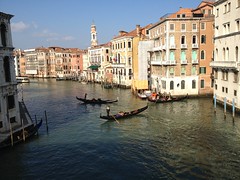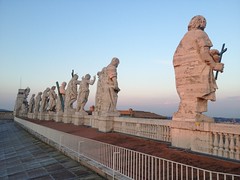Wednesday, February 20, 2013
Took the train up to fair Verona, some 100km inland from Venice.
It's a charming little city, sent in the loop of the River Fiume Adige, and was well known throughout Europe in Shakespeare's day, which is why, I guess, he set his tale of star crossed lovers in the city.
There were actually two warring families, but not necessarily a real Romeo and Juliet. The house of Juliet is there through, complete with balcony, which you can stand on. I drew the line at shinning up the Ivy to get there and relied on the stairs.
The clock tower gives a magnificent panorama of the whole valley. It was a bit foggy so the view was limited, but still stunning.
Monday, February 18, 2013
Who in their right mind would build a city in the ocean? Well the answer is the people of Venice who, over the past 1500 yeas have conquered the elements to construct a city that not only literally stands on the water, but is one of the most scenic on earth.
Nothing quite prepares you for the isolation of the city, now joined to land via a long railway bridge. It's not just off the shore, it's plumb in the middle of the bay, surrounded everywhere by bright blue water, teaming with boats of all sizes and shapes.
The city is bisected by the S bend of the Grand Canal with each half split into several sections by hundreds of small canals. Everywhere you go is water the only way to cross is by the small bridges. It is very up and down walking in Venice.
Part of the joy is the total lack of traffic, especially after the chaos of Naples and Rome. You can walk for miles and around every corner is another Plaza or Church.
Not sure what they are going to do about Global Warming though.
Sunday, February 17, 2013
Now leaving Rome after traipsing up, what felt like, most of the seven Hills of the City.
Visited the Capitoline Hill with its many museums and the plaza laid out by Micalangelo. The whole spot is now dominated by the monument to Victor Emmanuel II, one of only four kings of a unified Italy. It is a colossal building and they say the best view in Rome is from the top, mainly because you can't see the monument.
Also visited the Palatine Hill where the Emperors has their great palaces. Mostly ruins now you can see the house were Augustus lived. The complex is linked by many tunnels, designed so the Emperors could move about in safety. That didn't help Caligula though, who was stabbed to death in one of them.
Finally left the city to climb Vatican Hill for a wonderful view from the top of St Peters, just as the sun was setting.
Friday, February 15, 2013
Traveled up to Roma on the train on Wednesday, just a couple of hours north of Napoli.
You can't help by gape at the sheer history that is flung in your face as you enter the city. Everywhere you look there are ancient roads, aqueducts and buildings, testament to the time when this was indeed the capital of the World and the most powerful city on earth.
There was history taking place over the bridge at the Vatican, evidenced by the number of TV trucks parked just off St Peter's square.The crowd to get into St Peter's was so long I headed instead to the Vatican Museums where some of the treasures contained within. They certainly have a lot of material goods stuffed away for a rainy day.
The Sistine Chapel was packed as usual. Some very nice paintings, a bit over the top really but when you have it, flaunt it. Give the cardinals something to look at when they are communing with the Holy Ghost next month.
Wednesday, February 13, 2013
Still raining but I took my brolly and traveled to the other casualty of the mighty eruption of AD79, the little fishing port of Herculaneum. It wasn't rain that poured onto the town in 79, but millions of tons of boiling mud, which sealed the city in a flash, preserving buildings, furniture and even wall paintings, keeping them secret from the world until rediscovered in the 18th Century.
Before the mud hot, the people who hadn't evacuated after the first eruption were hit by a Pyroclastic flow from the Volcano, consisting of a wall of superheated gas, around 500 degrees Centigrade, providing instant cremation for the unlucky victims. The event was so quick that wood, brick and even bones were preserved having had all the moisture blown from them. The buildings are in a pretty good condition and it is easy to imagine the hustle and bustle of the inns and taverns along the main street. I would guess it looked pretty much as the centre of Naples does today. The only difference being the TV in the front room.
Around 3 million people still live on the slopes of the mountain. It must be like living in front of a loaded gun. The Volcano is not spent, it merely sleeps, and another eruption is long overdue.
Monday, February 11, 2013
Rather wet today so stayed around the historic centre of Naples, which stands today much as it has done for thousands of years, a maze of narrow alleys and cluttered buildings.
Took a trip down to the array of caves which spread below the city, mirroring the street above. You get there by squeezing through some rather tight tunnels, just 50cm wide, not for the claustrophobic. The tunnels link a series of caves, first hewn out by Greek settlers who quarried the rock to build the house above. Quite an amazing array, partly destroyed by allied bombing in the second World War.
Above in the centre of the city stands a church on the place where the old Roman forum once stood, and some houses still incorporate parts of the building which once housed the Roman theatre, where once the Emperor Nero entertained plebeians.
Sunday, February 10, 2013
First full day in Naples, so I took the train around the bay to visit the wonderfully evocative ruins at Pompeii.
It's an amazing place, a whole city was wiped out in AD79 when the Mighty Vesuvius, standing watch over the city like a slumbering giant, took offence and covered the place in ash and gas, spewed out from deep within the earth's belly. The population didn't stand a chance and died where they fell, their only legacy a body imprint in the solidified ash which, 2000 years later gives form to their memories.
The houses, temples and shops stand much as they did in the Augustine age, giving a sense of what a real roman city was like.





